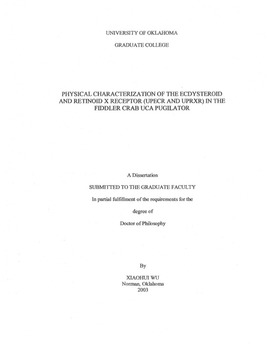| dc.contributor.advisor | Durica, David S., | en_US |
| dc.contributor.author | Wu, Xiaohui. | en_US |
| dc.date.accessioned | 2013-08-16T12:19:17Z | |
| dc.date.available | 2013-08-16T12:19:17Z | |
| dc.date.issued | 2003 | en_US |
| dc.identifier.uri | https://hdl.handle.net/11244/685 | |
| dc.description.abstract | Ecdysteroid hormones regulate growth, metamorphic differentiation, vitellogenesis, and oogenesis in insects. In crustaceans, molt, limb regeneration, and reproduction are closely related to ecdysteroid titers. In the fiddler crab, Uca pugilator, limb regeneration is coordinated with the molt cycle. Both limb regeneration and molting correlate with the fluctuation of circulating ecdysteroid titers. The actions of ecdysteroids are mediated through a nuclear receptor (NR), the ecdysteroid receptor (EcR). EcR needs to dimerize with another nuclear receptor, the insect ultraspiracle (USP) protein, or its vertebrate homolog, retinoid X receptor (RXR), to form a functional receptor dimer. A functional EcR/USP(RXR) heterodimer regulates gene expression by binding to a specific DNA sequence in the promoter region, the ecdysteroid hormone responsive element (HRE), or EcRE. Both EcR and USP/RXR can exist as multiple forms with variant amino acid (aa) sequences, or isoforms. Most characterized insect EcRs and USPs have amino-terminal (N-terminal) variant isoforms. Studies in insects and vertebrates show that specific NR isoforms exhibit tissue and cell type specific expression, suggesting receptor isoform specific physiological function. | en_US |
| dc.description.abstract | Initial physical characterization of E. coli and in vitro synthesized UpEcR and UpRXR(-5+33) suggest that these crab receptors, just like insect EcR and USP/RXR, are able to heterodimerize. (Abstract shortened by UMI.) | en_US |
| dc.description.abstract | EcR and RXR gene homologs in U. pugilator ( UpEcR and UpRXR) have been previously cloned. Library screenings recovered cDNA clones containing a unique amino terminal open-reading frame (A/B domain) for each gene, most similar to insect EcR-B1 and USP1/RXR isoforms. Several UpRXR cDNA splicing variants, however, are found in coding regions that could potentially influence function. A five-aa insertion/deletion is located in the "T" box in the hinge region. Another 33-aa insertion/deletion is found inside the ligand-binding domain (LBD), between helix 1 and helix 3. All these UpRXR mRNA variants are expressed in regenerating limb buds, and the predominant mRNA isoform represents the UpRXR(-5+33) isoform. | en_US |
| dc.format.extent | ix, 213 leaves : | en_US |
| dc.subject | Gene expression. | en_US |
| dc.subject | Biology, Zoology. | en_US |
| dc.subject | Nuclear receptors (Biochemistry) | en_US |
| dc.subject | Ecdysteroids. | en_US |
| dc.subject | Biology, Molecular. | en_US |
| dc.subject | Fiddler crabs. | en_US |
| dc.title | Physical characterization of the ecdysteroid and retinoid X receptor (UpEcR and UpRXR) in the fiddler crab Uca pugilator. | en_US |
| dc.type | Thesis | en_US |
| dc.thesis.degree | Ph.D. | en_US |
| dc.thesis.degreeDiscipline | Department of Biology | en_US |
| dc.note | Major Professor: David S. Durica. | en_US |
| dc.note | Source: Dissertation Abstracts International, Volume: 64-11, Section: B, page: 5371. | en_US |
| ou.identifier | (UMI)AAI3112349 | en_US |
| ou.group | College of Arts and Sciences::Department of Biology | |
